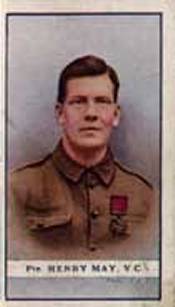Henry May (VC) facts for kids
Quick facts for kids
Henry May
|
|
|---|---|

Image from picture postcard of Henry May.
|
|
| Born | 29 July 1885 Bridgeton, Glasgow, Scotland |
| Died | 26 July 1941 (aged 55) Glasgow, Scotland |
| Buried |
Riddrie Park Cemetery
|
| Allegiance | |
| Service/ |
|
| Years of service | 1902 - 1915 918 - 1919 |
| Rank | Lieutenant |
| Service number | 7504 |
| Unit |
|
| Battles/wars | World War I |
| Awards | Victoria Cross |
Lieutenant Henry May was a very brave Scottish soldier. He lived from 1885 to 1941. He received the Victoria Cross (VC). This is the highest award for bravery. It is given to soldiers in the British and Commonwealth forces. They get it for showing great courage when facing the enemy.
Henry May's Early Life
Henry May was born on July 29, 1885. His parents were William and Maggie May. He was born in Bridgeton, Glasgow, Scotland.
He went to Dalmarnock Public School in Bridgeton. When he was 17, he joined the British Army. This was on August 29, 1902. He served as a rifleman. A rifleman is a soldier who uses a rifle. He was part of the 1st Battalion, Cameronians (Scottish Rifles). He fought during World War I, also known as the First World War.
A Heroic Act: The Victoria Cross
On October 22, 1914, Henry May showed amazing bravery. This happened in France. He rescued another soldier, Lieutenant Douglas Graham. May pulled him 300 yards (about 274 meters). He did this while they were being shot at.
Earlier that same day, May tried to save another wounded man. He went to help him even though there was heavy gunfire. Sadly, the man died before May could reach him.
His brave actions were written about in the London Gazette. This is an official newspaper. The announcement was made on April 19, 1915. It said:
His Majesty the KING has been pleased to approve of the grant of the Victoria Cross to the undermentioned Officer, Non-commissioned Officer and Men for their conspicuous acts of bravery and devotion to duty whilst serving with the Expeditionary Force: —
[...]
No. 7504 Private Henry May, 1st Battalion, The Cameronians (Scottish Rifles).
For most conspicuous bravery near La Boutillerie, on 22nd October, 1914, in voluntarily endeavouring to rescue, under very heavy fire, a wounded man, who was killed before he could save him, and subsequently, on the same day, in carrying a wounded Officer a distance of 300 yards into safety whilst exposed to very severe fire.
King George V himself gave Henry May his Victoria Cross. This special ceremony happened on August 12, 1915.
Life After the War
Henry May left the Army on August 28, 1915. He had served for 13 years. But he rejoined the Army in 1918. He became a Lieutenant in the Army Service Corps.
After the war, May worked in the textiles industry. He passed away on July 26, 1941. He is buried in Riddrie Park Cemetery in Glasgow.
His Victoria Cross medal is on display. You can see it at the Cameronians Regimental Museum. This museum is inside Hamilton Low Parks Museum in Hamilton, Scotland.
In October 2014, a special stone was placed in Glasgow. It was an engraved granite paving stone. It was laid outside the People's Palace. This was to remember Henry May and his bravery. His grandchildren attended the ceremony. Glasgow's Depute Lord Provost unveiled the memorial. He said that May was one of the few men in the Great War who survived. He performed an "ultimate act of valour." This means he risked his life to save his friends. The Lord Provost said May deserved "utmost respect."

